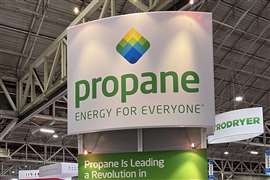Read this article in Français Deutsch Italiano Português Español
The case for renewable propane
19 June 2024
Propane is a fossil fuel produced in abundance in the United States — so much so that the U.S. is a net exporter of the fuel. According to the U.S. Energy Information Administration’s “Petroleum Supply Monthly” for February 2024, more than 733 million barrels of propane were produced in the U.S. in 2023, with exports of over 582 million barrels — or about 79 percent of total propane production.
According to the Alternative Fuels Data Center (AFDC) of the U.S. Dept. of Energy (DOE), fossil propane already offers emissions advantages over other fuels. For instance, because it has a lower carbon content than either gasoline or diesel fuel, propane can offer lower lifecycle greenhouse gas (GHG) emissions.
“When you compare it with diesel, for example, it produces almost 96 percent lower nitrogen oxides (NOx) emissions and almost 99 percent lower particulate matter emissions,” said Sai Satish Guda, PERC’s manager of research and development.
Nevertheless, the Propane Education & Research Council (PERC) is actively working to foster the growth of renewable propane — propane that is purpose-made from a variety of renewable feedstocks — as a fuel source.
According to the organization’s website, renewable propane is an even cleaner alternative to fossil propane due to its lower carbon intensity. This is a result of being produced from renewable sources.
Additionally, during a recent Engine Technology Forum webinar entitled, “How Propane is Evolving for the Future,” Gavin Hale, director of product development and power generation for PERC, said renewable propane is molecularly identical to its fossil counterpart.
“So, any engine or vehicle you’re running today with standard propane — renewable propane will work,” he said.
Alternative Fuel Byproduct
One way renewable propane is produced today is via the production of other alternative fuels.
 Sai Satish Guda, manager of research and development for PERC. (Photo: Propane Education & Research Council)
Sai Satish Guda, manager of research and development for PERC. (Photo: Propane Education & Research Council)
Guda said the fuel comes as a byproduct of the hydrotreating process used to make either renewable diesel — also known as hydrotreated vegetable oil (HVO) — or sustainable aviation fuel (SAF). This process essentially works to remove oxygen from long-chain oil and fat molecules while adding hydrogen and moving to the next steps of isomerization and cracking, Guda said.
“In this process, you’re also producing alkanes, which are nothing but propane, butane — things like that,” he said.
Guda added that this hydrotreating process has two phases, and the effort with which cracking is carried out and hydrogen is added during the second phase results in either HVO or SAF.
“Irrespective of what the process is in terms of getting the end product, renewable propane is a byproduct that you cannot avoid,” he said.
The market for this renewable propane — outside of what refineries may consume for their own use — offers a strong value proposition, Guda said. He cited a feasibility study by the National Renewable Energy Lab (NREL) that identified these economic benefits.
The October 2022 study entitled, “Techno-economic, Feasibility, and Life Cycle Analysis of Renewable Propane,” said the capital recovery payback period for biorefineries producing 3.5 million gallons per year of renewable propane is 14 months. For those producing 87 million gallons annually, the payback period is as short as two months.
Using Nonfood Crops
PERC is also working with various partners to investigate other ways of producing renewable propane.
“We actually have strategic partnerships with universities, several research institutes, for looking at on-purpose renewable production pathways,” Guda said. “Because there’s so much demand, you just cannot look at producing it as a byproduct. The feedstock is kind of limited. There are a lot of renewable fuels being produced from a single feedstock, so you should never put all your eggs into one basket.”
Hale said certain nonfood crops are becoming increasingly viable as feedstocks. He added that the benefit of using a nonfood crop is that it’s easier to determine its carbon intensity.
 Camelina is a nonfood cover crop the seed oil of which can serve as feedstock for renewable propane. (Photo: Propane Education & Research Council)
Camelina is a nonfood cover crop the seed oil of which can serve as feedstock for renewable propane. (Photo: Propane Education & Research Council)
“Because when you use a waste product, what was the heritage of that waste product?” Hale said. “What does it take to turn it into a renewable product? And what was the penalty in terms of emissions? With a nonfood feedstock, you kind of avoid that.”
One potential nonfood crop feedstock is a cover crop called camelina. Specifically, the feedstock is the plant’s seed oil. The PERC website said camelina, a member of the mustard family, is related to cabbage and cauliflower but is not a food crop.
“Camelina is basically a weed,” Hale said. “It grows in drought conditions and wet conditions and the yield of oil for each one of [its seeds] is incredibly high. So, this is a crop that’s being sponsored globally for renewable propane production. It works really well here in the U.S.”
PERC’s website said the seed produces 40 percent oil, which is twice that of soybeans.
Production Forecast
Hale said that in 2023, renewable propane production hit 4.5 million gallons. The AFDC appeared to agree with this number, saying on its website that this is the current production capacity for renewable propane.
Hale added that capacity is forecast to grow dramatically, with 2024 projections at 20 million gallons and 2025 at 70 million gallons. He said PERC hopes to see 10 billion gallons of renewable diesel produced annually by 2040.
POWER SOURCING GUIDE
The trusted reference and buyer’s guide for 83 years
The original “desktop search engine,” guiding nearly 10,000 users in more than 90 countries it is the primary reference for specifications and details on all the components that go into engine systems.
Visit Now
STAY CONNECTED




Receive the information you need when you need it through our world-leading magazines, newsletters and daily briefings.
CONNECT WITH THE TEAM
















